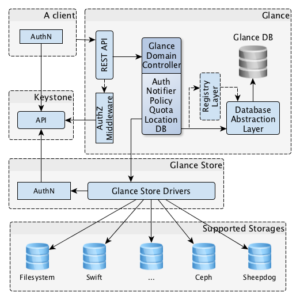
What is OpenStack?
OpenStack is a free and open-source software platform for cloud computing, mostly deployed as infrastructure-as-a-service (IaaS), whereby virtual servers and other resources are made available to customers. The software platform consists of interrelated components that control diverse, multi-vendor hardware pools of processing, storage, and networking resources throughout a data center.
OpenStack is a set of software tools for building and managing cloud computing platforms for public and private clouds. Backed by some of the biggest companies in software development and hosting, as well as thousands of individual community members, many think that OpenStack is the future of cloud computing.
OpenStack lets users deploy virtual machines and other instances that handle different tasks for managing a cloud environment on the fly. It makes horizontal scaling easy, which means that tasks that benefit from running concurrently can easily serve more or fewer users on the fly by just spinning up more instances. For example, a mobile application that needs to communicate with a remote server might be able to divide the work of communicating with each user across many different instances, all communicating with one another but scaling quickly and easily as the application gains more users.
What are the key components of OpenStack?
Horizon: the only GUI in OpenStack; the first component administrators see and get an idea of the current operations in the cloud.
Nova: chief computing engine to handle multiple virtual machines and computing tasks
Swift: reliable and robust storage system for files and objects helping developers to refer to a unique identifier and Openstack decides where to store the info.
Cinder: similar to traditional computer storage system, it is a block storage system in OpenStack for accessing files at faster speed.
Neutron: ensures efficient connectivity between components during deployment.
Keystone: a central identity list of all OpenStack cloud users and provides various mapping techniques to access methods against Keystone.
Glance: image service provider where images are the virtual copies of hard disks. Allows using the images as templates during deployment of new instances.
Ceilometer: component providing billings services and other telemetry services to cloud users. Maintains an account of component system usage by each user.
Heat (Orchestration Engine): Allows developers to orchestrate/illustrate and store the cloud application requirements and resources needed in a file, thereby maintaining the cloud infrastructure.
Specify what are the three parts that make the OpenStack modular architecture?
The three parts that make modular architecture for OpenStack are:
OpenStack Compute: For overseeing extensive systems of the virtual machine.
OpenStack Object Storage: The storage framework that offers help for both object storage and block storage.
Image Service: The conveyance service gives disclosure and enlistment to virtual disk pictures
What is the use of $ nova floating-ip-pool-list command in OpenStack?
The $ nova floating-ip-pool-list command is used to list IP address information in OpenStack.

Explain the usage of Cinder in OpenStack?
OpenStack Cinder is used to handle block storage in the context of OpenStack.
What you will do in case of server failure?
If a server is having hardware issues, it is a good idea to make sure the Object Storage services are not running. This will allow Object Storage to work around the failure while you troubleshoot OpenStack.
If the server just needs a reboot, or a small amount of work that should only last a couple of hours, then it is probably best to let Object Storage work around the failure and get the machine fixed and back online. When the machine comes back online, replication will make sure that anything that is missing during the downtime will get updated.
If you cannot replace the drive immediately, then it is best to leave it unmounted, and remove the drive from the ring. This will allow all the replicas that were on that drive to be replicated elsewhere until the drive is replaced. Once the drive is replaced, it can be re-added to the ring.
List down the components of OpenStack Compute
Nova (Compute) Cloud comprises following components:
API server
Message Queue (Rabbit-MQ Server)
Compute Workers (Nova-Compute)
Network controller (Nova-Network)
Volume Worker
Scheduler
What storage types are allowed by OpenStack Compute?
OpenStack Cloud Operating system supports two types of storage:
Persistent Storage: Persistent and independent of any particular instance, created by users. This further includes three storage:
Object storage: to access binary objects through the REST API.
Block storage: offers access-to-block storage devices by affixing volumes their current VM instances.
Shared File System storage: provides a set of services to manage multiple files together for storage and exchange with multiple users at one time.
Ephemeral Storage: Referring to a single instance. As the name suggests, these storage options are temporary and short-lived and disappear once the VM is terminated.Interested in a high-paying career in Cloud Computing?
Define ‘users,’ ‘role’ and ‘tenant’ in OpenStack.?
Users can be members of multiple projects:
Tenant is a group of users and an alternative term for Project/accounts where projects are organizational units in cloud processing
Role is the position to which a user is mapped (the authorization level). Roles are usually assigned to project-user duos.
What are functions and features of Swift?
Storage of large sized objects
Storage of large number of objects
Data Redundancy
Archival capabilities – Work with large datasets
Data container for virtual machines and cloud apps
Media Streaming capabilities
Secure storage of objects
Extreme scalability
Backup and archival
Define Identity Service in OpenStack?
Keystone is the most important and preferred Identity Service in OpenStack and executes the complete OpenStack Identity API. The Keystone Identity Service is responsible for user management and service catalog. In user management, it tracks users and their permissions while Service Catalog offers a list of services available with their API. The former provides authentication credential details of users, tenants and roles.
Internal services like Token and Policy are also part of Keystone Identity
Are you Looking for OpenStack Training? Please Enroll for Demo OpenStack..! |
List down the type of Hypervisors supported by OpenStack.
KVM (Kernel-based Virtual machine)
LXC: Linux Containers having Linux-based VMs
QEMU: Quick EMUlator used for development purposes
UML: User Mode Linux used for development purposes
VMware vSphere: VMware-based Linux and Windows via vCenter server connection.
Hyper-V: Server virtualization with Microsoft’s Hyper-V
Name the commands used to pause and un-pause(resume) an instance
# novaunpause INSTANCE_NAME
# nova pause INSTANCE_NAME
List the storage locations for VM images in OpenStack
• OpenStack Object Storage
• Filesystem
• S3
• HTTP
• RBD or Rados Block Device
• GridFSMaster Openstack from industry experts. Find out more in this openstack Blog now.












